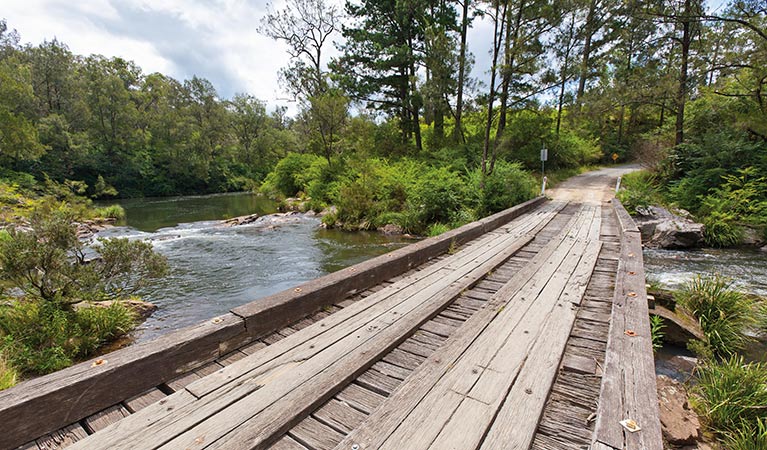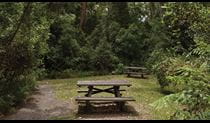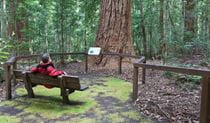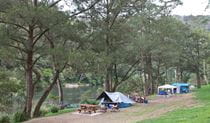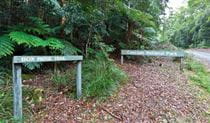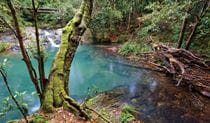Moonpar Forest drive
North Coast
Overview
Moonpar Forest drive is a 75km scenic car touring route near Dorrigo. It’s a great day out and an ideal way to explore the walks, riverside picnic spots, and sights of Nymboi-Binderay and Cascade national parks.
- Where
- Cascade National Park, Junuy Juluum National Park, Nymboi-Binderay National Park in North Coast
- Accessibility
- Medium
- Distance
- 75km loop
- Time suggested
- 5hrs
- Opening times
Moonpar Forest drive is open at all times, but may close due to poor weather, flood or fire danger.
- What to
bring - Hat, sunscreen, drinking water, binoculars, snacks
- Please note
The bridge over Nymboida River is subject to flooding, so please check for closures before setting out.
Starting at Dorrigo, this scenic forest drive loops through Nymboi–Binderay National Park and Cascade National Park. Allow a day so you can make the most of the many bushwalks, riverside stops and sightseeing opportunities along the way.
Stop for morning tea at Norman Jolly picnic area before stretching your legs along short and easy Coachwood loop track. Here you can marvel at the giant tallowwood trees that are around 800 years-old. Take advantage of the facilities at Platypus Flat campground for lunch by the Nymboida River. Bring your swimsuit and towel so you can take a refreshing dip in the river.
The river attracts plenty of wildlife, so keep an eye out for turtles, cormorants, and platypus. Wild ducks raise their young on the banks of the river, and you might see kingfishers, lorikeets and lace monitors.
Continue to nearby Cascade National Park, where you can spend the afternoon exploring along Box Ridge walking track and Mobong walking track. Discover the relics from the the timber industry days, including an old railway station, before heading south towards Dorrigo to complete the loop.
Along the way
Map
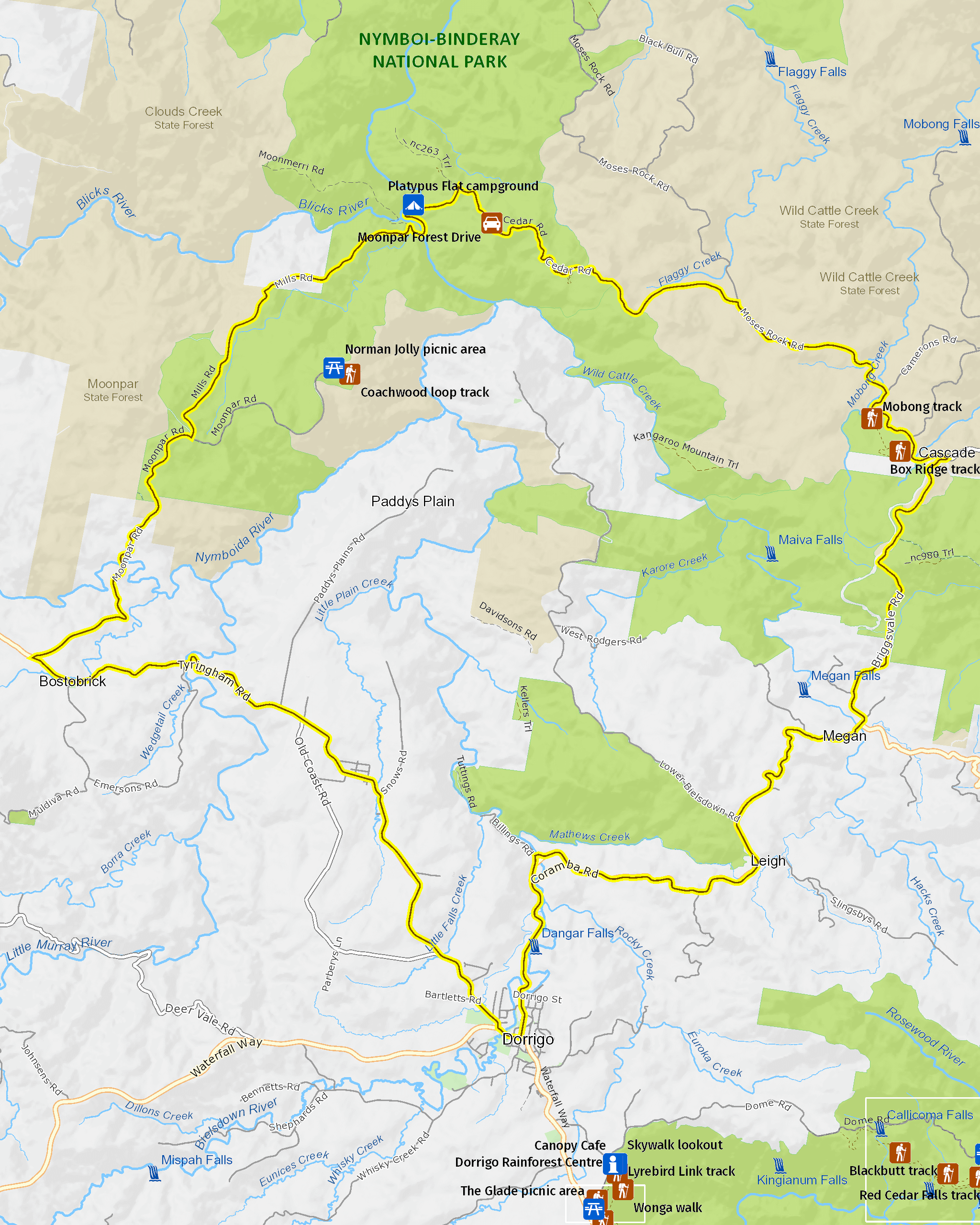
Map legend

Local alerts
For the latest updates on fires, closures and other alerts in this area, see https://www.nationalparks.nsw.gov.au/things-to-do/driving-routes/moonpar-forest-drive/local-alerts
General enquiries
- National Parks Contact Centre
- 7am to 7pm daily
- 1300 072 757 (13000 PARKS) for the cost of a local call within Australia excluding mobiles
- parks.info@environment.nsw.gov.au
Park info
- in Nymboi-Binderay National Park in the North Coast region
Nymboi-Binderay National Park is always open but may have to close at times due to poor weather or fire danger.
- in Cascade National Park in the North Coast region
Cascade National Park is always open but may have to close at times due to poor weather or fire danger.
- in Junuy Juluum National Park in the North Coast region
Visitor info
All the practical information you need to know about Moonpar Forest drive.
Getting there and parking
Get driving directions
Moonpar Forest drive is located in Nymboi–Binderay and Cascade national parks. To get there:
- From Dorrigo, travel north along Tyringham Road
- Turn right onto Moonpar Road
- Turn left onto Mills Road
- Shortly after crossing Nymboida River, turn right onto Cedar Road
- Turn right onto Moses Rock Road and follow to Cascade
- From here, follow the signs back to Dorrigo.
Road quality
Check the weather before you set out as the road can become boggy when it rains.
Parking
Parking is available along the way at Norman Jolly picnic area, Platypus Flat and at the start of Red Cedar and Tramline walks.
Best times to visit
There are lots of great things waiting for you in Nymboi-Binderay National Park. One of the highlights of a visit to the park is a whitewater rafting trip down the Nymboida River. Spring is a great time to head out on a guided tour.
Weather, temperature and rainfall
Summer temperature
Average
18°C and 29°C
Winter temperature
Average
5°C and 20°C
Rainfall
Wettest month
March
Driest month
August
The area’s highest recorded rainfall in one day
388mm
Facilities
- Toilet and picnic facilities are located at Platypus Flat campground and Norman Jolly picnic area.
- Drinking water is limited or not available in this area, so it’s a good idea to bring your own.
- You’re encouraged to bring gas or fuel stoves, especially in summer during the fire season.
Maps and downloads
Accessibility
Disability access level - medium
- Assistance may be required to access this area.
- Norman Jolly picnic area is wheelchair-accessible. The area also has an accessible toilet and carpark.
Permitted
Fishing
A current NSW recreational fishing licence is required when fishing in all waters.
Prohibited
Pets
Pets and domestic animals (other than certified assistance animals) are not permitted. Find out which regional parks allow dog walking and see the pets in parks policy for more information.
If you're travelling through a national park or reserve on a public road you can have pets inside your vehicle. However, you must keep them inside your vehicle while driving through national parks or reserves. You must also comply with any conditions in the park’s plan of management, and you cannot stop to visit the park or use park facilities (unless for safety reasons, or to use publicly accessible toilets).
Smoking
NSW national parks are no smoking areas.
Learn more
Moonpar Forest drive is in Nymboi-Binderay National Park. Here are just some of the reasons why this park is special:
Ancient connections
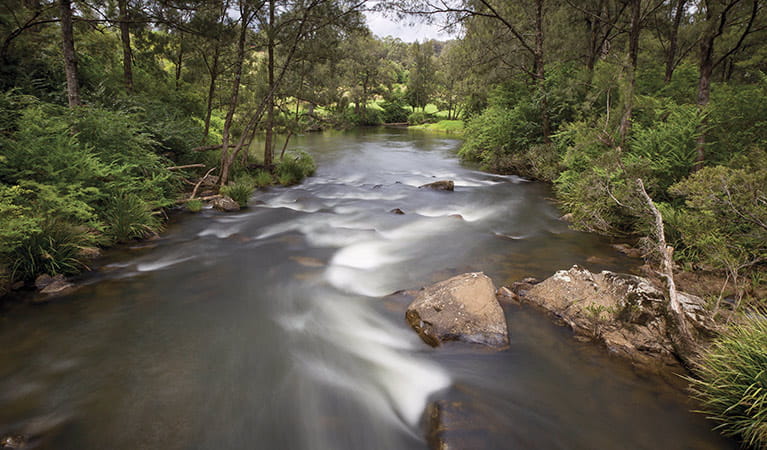
Nymboi-Binderay National Park is the traditional Country of the Gumbaynggirr People and their ancient connection to this land is evident throughout the park. The park's landscape provided a rich source of food, medicine and shelter for Aboriginal people and features strongly in cultural knowledge and Dreaming stories. As you travel through this park, take some time to think about the people who lived here and their strong attachment to this ancient landscape and all it contains.
Animal kingdom
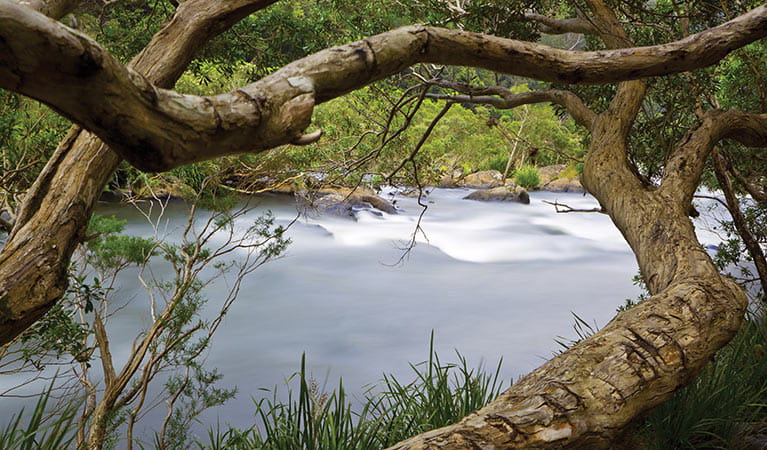
Nymboi-Binderlay has a diverse range of animals, including 68 types of mammal, 25 kinds of amphibian, 33 sorts of reptile and over 120 bird species; of these, at least 15 species are threatened. When you’re picnicking, camping or walking through the tallowwood and coachwood rainforests, be sure to keep your eyes open for the many native animals which call this place home.
- Moonpar Forest drive Moonpar Forest drive is a 75km scenic car touring route near Dorrigo. It’s a great day out and an ideal way to explore the walks, riverside picnic spots, and sights of Nymboi-Binderay and Cascade national parks.
- Norman Jolly picnic area Enjoy a picnic among tall old-growth trees and historic logging relics at Norman Jolly picnic area in Nymboi-Binderay National Park, not far from Dorrigo.
Waterworld
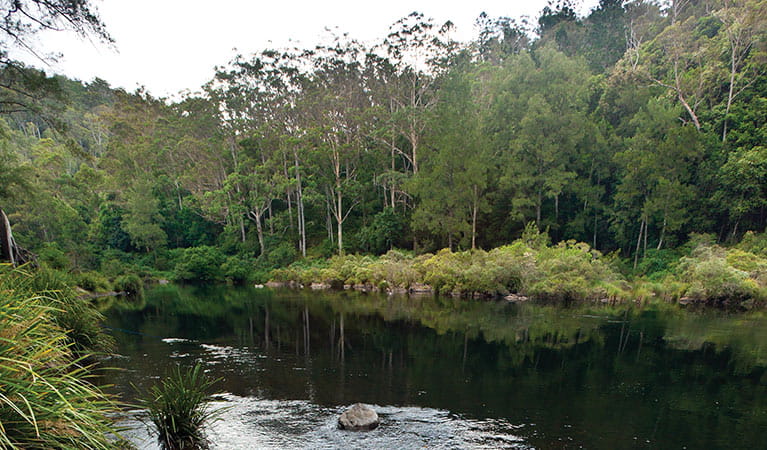
The Nymbodia River is a true highlight of Nymboi-Binderay National Park. The name of the park comes from Aboriginal language of the local Gumbaynggirr People; 'Nymboi' being their name for the river, and 'Binderay' meaning river. Rafting down the Nymboi River with an expert guide is an exhilarating experience and a fantastic way to take in the park's landscape.
- Coachwood loop track The Coachwood loop track is a short and easy walk that starts and finishes at the Norman Jolly picnic area in Nymboi-Binderay National Park.
- Moonpar Forest drive Moonpar Forest drive is a 75km scenic car touring route near Dorrigo. It’s a great day out and an ideal way to explore the walks, riverside picnic spots, and sights of Nymboi-Binderay and Cascade national parks.
Plants and animals protected in this park
Animals
-
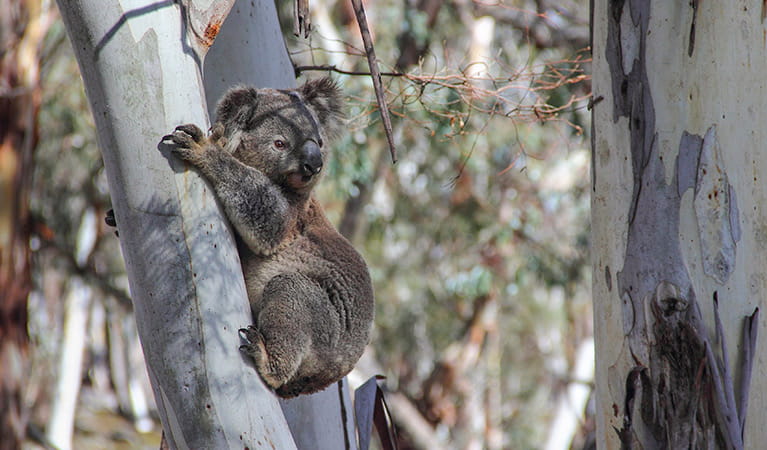
Koala (Phascolarctos cinereus)
One of the most renowned Australian animals, the tree-dwelling marsupial koala can be found in gum tree forests and woodlands across eastern NSW, Victoria and Queensland, as well as in isolated regions in South Australia. With a vice-like grip, this perhaps most iconic but endangered Australian animal lives in tall eucalypts within a home range of several hectares.
-

Superb lyrebird (Menura novaehollandiae)
With a complex mimicking call and an elaborate courtship dance to match, the superb lyrebird is one of the most spectacular Australian animals. A bird watching must-see, the superb lyrebird can be found in rainforests and wet woodlands across eastern NSW and Victoria.
-

Southern boobook (Ninox novaeseelandiae)
The southern boobook, also known as the mopoke, is the smallest and most common native owl in Australia. With a musical 'boo-book' call that echoes through forests and woodlands, the southern boobook is a great one to look out for while bird watching.
Plants
-
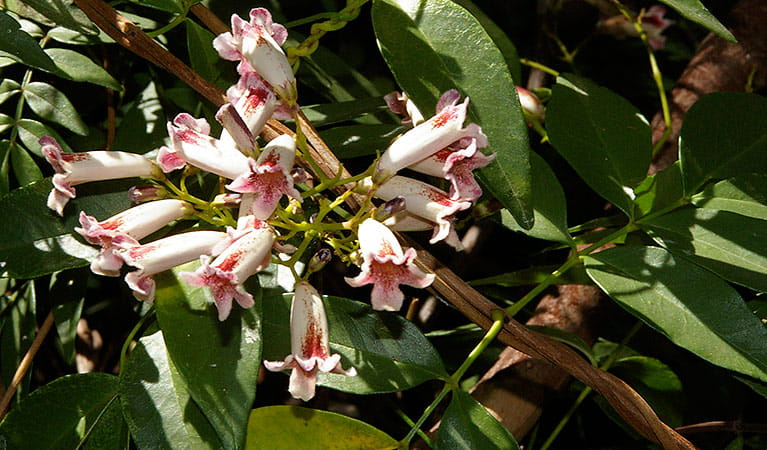
Wonga wonga vine (Pandorea pandorana)
The wonga wonga vine is a widespread vigorous climber usually found along eastern Australia. A variation of the plant occurs in the central desert, where it resembles a sprawling shrub. One of the more common Australian native plants, the wonga wonga vine produces bell-shaped white or yellow flowers in the spring, followed by a large oblong-shaped seed pod.
-
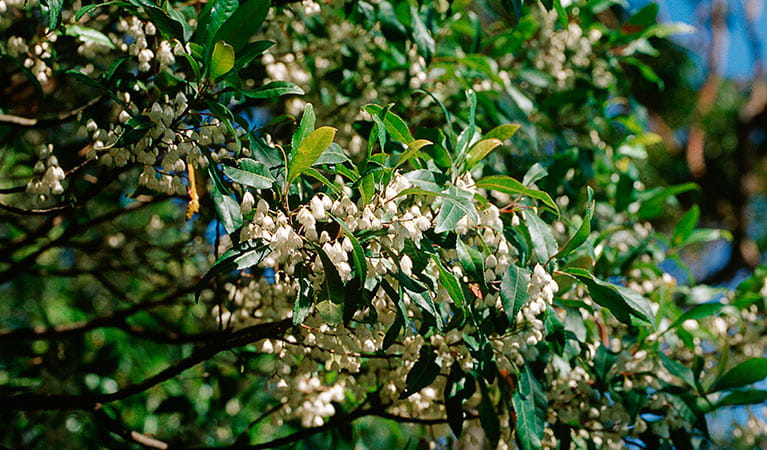
Blueberry ash (Elaeocarpus reticulatus)
The blueberry ash is a rainforest shrub which produces blue olive-shaped berries and spectacular bell-shaped flowers, which often appear on the plant together. It is a tall slender shrub or small tree found in rainforest, tall eucalypt forest and coastal bushland in eastern NSW, south-east Queensland and Victoria.

